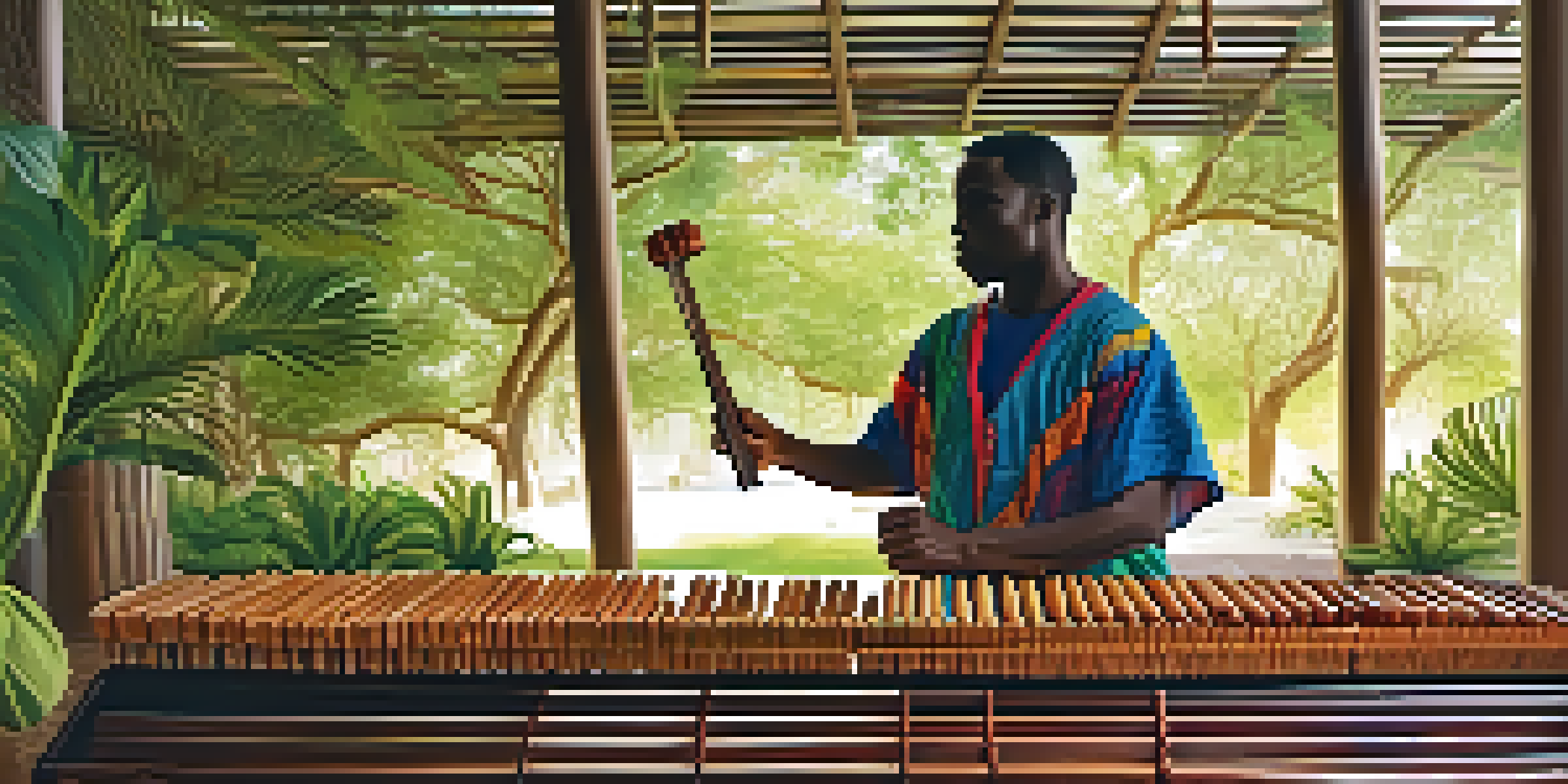Marimba: The African Instrument That Inspires Global Music

The Origins of the Marimba in Africa
The marimba, a percussion instrument with deep roots in African culture, originated in the 14th century. It is believed to have evolved from earlier xylophones and has been used in various traditional ceremonies and storytelling practices. Its unique sound, produced by wooden bars struck with mallets, evokes a rich history of community and celebration.
Music is the shorthand of emotion.
In many African countries, the marimba is more than just an instrument; it serves as a vital part of cultural identity. For example, in Zimbabwe, the instrument is often played during social gatherings and rituals, bridging generations through music. This communal aspect of the marimba highlights its role in fostering connections among people.
As the marimba spread across the continent, different regions developed their own styles and techniques, enriching the instrument's versatility. Today, it has become a symbol of African heritage, celebrated not only within its birthplace but also around the globe.
The Structure and Sound of the Marimba
The marimba consists of a series of wooden bars of varying lengths, each producing a distinct pitch when struck. Beneath these bars, resonators amplify the sound, creating a warm, rich tone that is both melodic and rhythmic. This unique combination is what makes the marimba stand out among other percussion instruments.

Each marimba can differ in size and design, affecting its sound and playing style. Some marimbas have a lower range, similar to a bass, while others are tuned to higher pitches, akin to a piano. This diversity allows musicians to explore a wide range of musical genres, from traditional African music to contemporary compositions.
Marimba's Cultural Significance
The marimba is a vital instrument in various African cultures, serving as a bridge between generations and a symbol of cultural identity.
Many marimba players incorporate techniques like damping and glissando to create expressive melodies. The interplay of rhythm and melody invites listeners into a captivating world, demonstrating how this instrument can evoke a range of emotions and stories.
The Marimba's Journey to the Global Stage
As cultural exchanges increased, the marimba found its way into various music scenes worldwide. The mid-20th century saw a surge in interest, particularly in the United States, where musicians began incorporating its sounds into jazz and classical compositions. This crossover sparked a newfound appreciation for the instrument's unique qualities.
The marimba is not just an instrument; it is a voice that speaks the language of our culture and connects us to our roots.
Notable artists, such as the renowned marimbist, Keiko Abe, have played a significant role in popularizing the marimba outside of Africa. By showcasing its versatility in solo performances and collaborations, these musicians have inspired many to explore its rich sound. The marimba's presence in global music festivals further solidifies its status as a beloved instrument.
This international appeal has led to the creation of marimba ensembles and orchestras, promoting collaboration among diverse musicians. Through these collective efforts, the marimba continues to bridge cultural divides and inspire creativity in various musical landscapes.
Marimba in Contemporary Music Genres
Today, the marimba is making waves in a variety of contemporary music genres, from pop to world music. Its distinctive sound has been sampled and incorporated into tracks by popular artists, adding a fresh and unique layer to modern compositions. This fusion of styles highlights the marimba's adaptability and relevance in today's music scene.
Musicians like the band 'The Marimba Project' have gained recognition for their innovative use of the marimba in fusion genres, blending traditional African rhythms with contemporary beats. This creative synergy showcases the instrument's potential to evolve while staying true to its roots. The result is a captivating sound that resonates with audiences across cultures.
Global Popularity of the Marimba
The marimba has gained international recognition, inspiring musicians worldwide to incorporate its unique sound into diverse genres.
Furthermore, collaborations between marimba players and artists from various genres continue to flourish. These partnerships not only expand the marimba's reach but also enrich the global music landscape, proving that music knows no boundaries.
Educational Impact of the Marimba
The marimba is also making a significant impact in music education, especially in schools and universities. Many educational programs are incorporating the marimba into their curricula, fostering a deeper understanding of rhythm and melody among students. This hands-on experience helps learners appreciate the cultural significance of the instrument while developing their musical skills.
Workshops and masterclasses led by skilled marimba players offer students the opportunity to learn directly from experts. These sessions not only teach technique but also emphasize the importance of cultural heritage in music. Through these educational initiatives, the marimba continues to inspire the next generation of musicians.
By introducing students to the marimba, educators are promoting cultural diversity and encouraging creativity. This exposure can ignite a passion for music and foster a sense of community among young learners, proving that the marimba is not just an instrument but a tool for connection and expression.
The Marimba's Role in Cultural Identity
For many communities, the marimba plays a crucial role in preserving cultural identity. It is often featured in traditional ceremonies, celebrations, and storytelling, serving as a reminder of ancestral roots. By participating in these practices, individuals connect with their heritage and the collective memory of their communities.
The marimba's presence in cultural events helps to strengthen bonds among community members. Through music, stories are shared, and traditions are passed down, creating a sense of belonging. This cultural continuity is vital, especially in an increasingly globalized world where unique identities can sometimes feel diluted.
Educational Impact of the Marimba
Incorporating the marimba into music education fosters appreciation for rhythm and cultural heritage among students.
Moreover, the marimba has become a symbol of resilience and pride for many African communities. As they navigate modern challenges, the instrument stands as a testament to their history and creativity, reminding them of their rich cultural tapestry.
The Future of the Marimba in Global Music
Looking ahead, the marimba's influence in global music is set to grow even further. With the rise of technology and digital platforms, more musicians are discovering the instrument and experimenting with its sound. This accessibility opens new avenues for collaboration and creativity, allowing the marimba to reach audiences that may not have encountered it otherwise.
As music continues to evolve, the marimba's adaptability will be key in shaping its future. Its ability to blend with various genres presents exciting opportunities for innovative compositions. Whether in a traditional setting or a contemporary stage, the marimba will undoubtedly continue to inspire musicians around the world.

Ultimately, the marimba serves as a reminder of the power of music to unite people across cultures. As it makes its mark on global music, the marimba not only preserves its rich heritage but also paves the way for new generations of artists to explore its enchanting sounds.